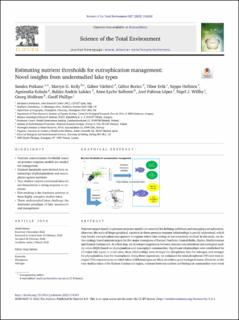| dc.description.abstract | Nutrient targets based on pressure-response models are essential for defining ambitions and managing eutrophication. However, the scale of biogeographical variation in these pressure-response relationships is poorly understood, which may hinder eutrophication management in regions where lake ecology is less intensively studied. In this study, we derive ecology-based nutrient targets for five major ecoregions of Europe: Northern, Central-Baltic, Alpine, Mediterranean and Eastern Continental. As a first step, we developed regressions between nutrient concentrations and ecological quality ratios (EQR) based on phytoplankton and macrophyte communities. Significant relationships were established for 13 major lake types; in most cases, these relationships were stronger for phosphorus than for nitrogen, and stronger for phytoplankton than for macrophytes. Using these regressions, we estimated the total phosphorus (TP) and total nitrogen (TN) concentrations at which lakes of different types are likely to achieve good ecological status. However, in the very shallow lakes of the Eastern Continental region, relations between nutrient and biological communities were weak or non-significant. This can be attributed to high nutrient concentrations (in the asymptotic zone of phosphorus-phytoplankton models) suggesting other factors (light, grazing) limit primary production. However, we also show that fish stocking is a major pressure on Eastern Continental lakes, negatively affecting ecological status: lakes with low fish stocking show low chlorophyll-a concentrations and good ecological status despite high nutrient levels, while the lakes with high fish stocking show high chlorophyll-a and low ecological status. This study highlights the need to better understand lakes in biogeographic regions that have been, for historical reasons, less studied. This, in turn, helps reveal factors that challenge the dominant paradigms of lake assessment and management. | en_US |

